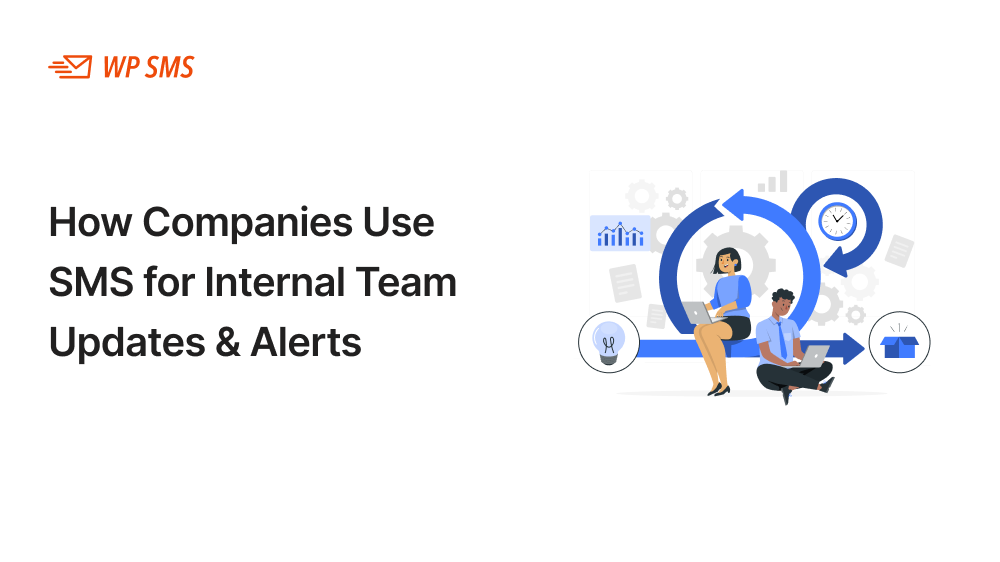Leverage SMS for employee communications.
SMS is the fastest and most personal communication channel for both personal and business use.
Apart from the SMS campaigns, you can run to interact with customers, and you can use SMS for internal communications.
Many times, you need to send urgent notifications to your employees or update them about their payments. You can’t rely on email or social groups because employees might check their inboxes late. SMS is the best choice for internal business communications.
In this blog post, we’ll explain how businesses can use WP SMS to automate their internal employee communications.
Why Use SMS for Employee Communications?
Emails may remain unread for hours or even days, even in the workplace. You can’t expect a fast response when you communicate by email.
On the other hand, SMS messages are usually opened within minutes. That’s why it’s great for urgent reminders and alerts.
Internal business communications are usually urgent, so SMS is the best channel for employee communication.
Here is a summary of the benefits of using SMS for internal communications in your business:
- High Open Rates: Our experience shows that SMS messages have an open rate of 98%, which is higher than emails.
- Speed and Reliability: Your employees receive messages instantly, making SMS an effective tool for urgent notifications.
- Mobile Accessibility: Employees can receive messages anywhere without an internet connection. This is great for emergency situations.
- Direct and Personal Messaging: SMS is concise, personal, and direct, so employees feel more valued when they receive your messages.
For these reasons, companies in different industries are using SMS in their internal communications, even if they have business email systems or communication apps like Slack.
Common Use Cases for SMS in Internal Business Communications
Here are some of the most common uses of SMS for employee communications.
1. Urgent Alerts & Emergency Notifications
When emergencies arise, your company needs a way to quickly alert its workers. Of course, email isn’t a good option, as it requires an internet connection and might be ignored in employees’ inboxes.
SMS is the simplest and fastest communication channel in situations like:
- Natural disasters
- Security threats
- Unexpected office closure
- Health emergencies
- Technical failures
- Transportation disruptions
SMS allows your business to instantly notify your staff and provide critical instructions and updates.
For example, if a fire breaks out in your office, you can send an automatic SMS alert to all employees:
Message
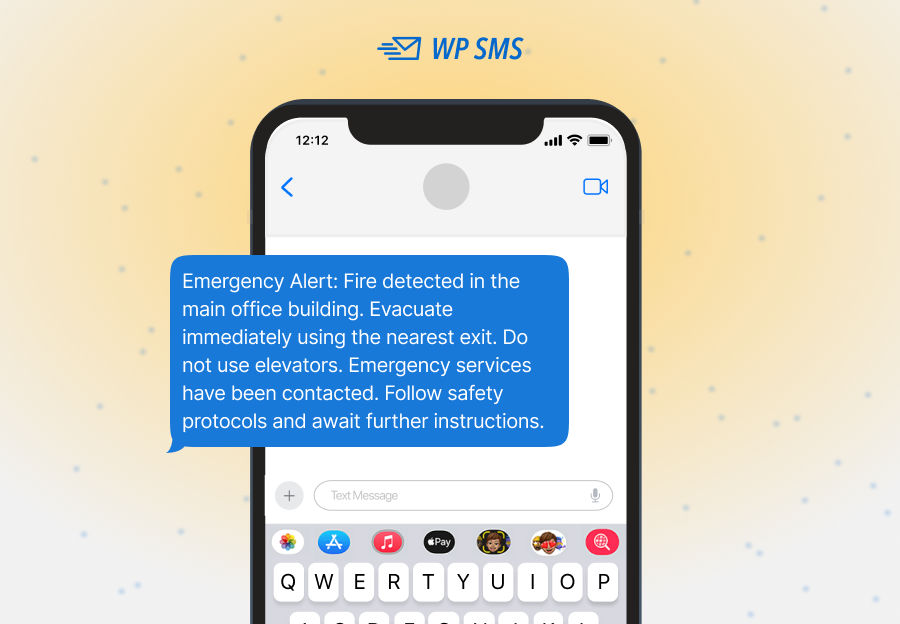
This way, you can provide them with evacuation details in the fastest way possible.
Also, if you decide on an office closure in the event of a severe weather warning, you don’t need to call each employee. SMS helps you quickly notify everyone.
Look at the SMS sample to see how it works:
Message
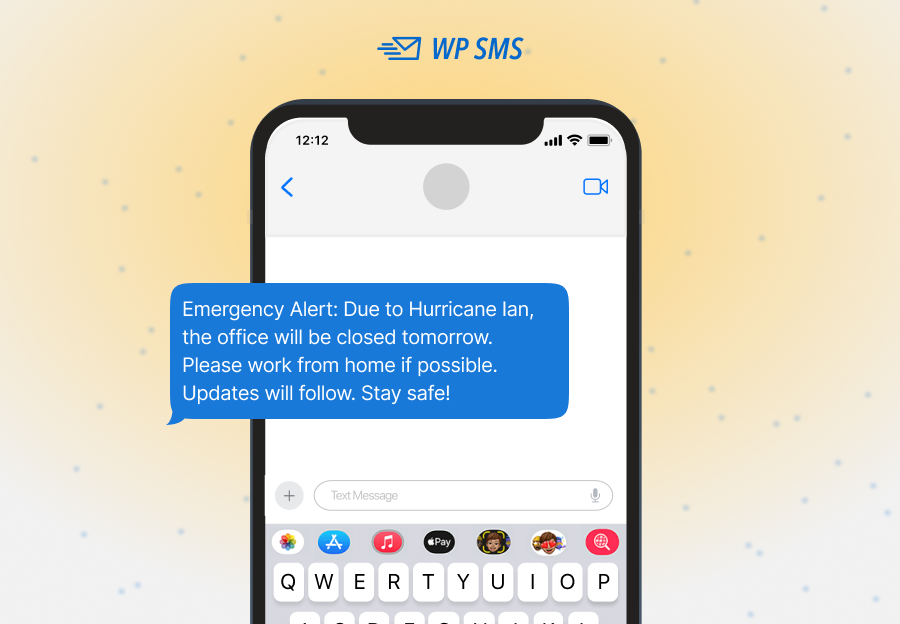
Remember that if you mention the office closure in social media groups, some employees might not read it, as many people don’t check their social accounts early in the morning.
2. Shift & Schedule Updates
Some industries face challenges with managing shifts because they have lots of employees with rotating schedules.
Sectors like retail, healthcare, and hospitality often struggle to manage employee shifts. Also, employees might forget their shifts.
SMS notifications are the best way to solve these problems. SMS lets you send:
- Real-time schedule updates
- Shift change notifications
- Reminders
For example, if you have a restaurant, you can notify waiters about an open shift via SMS. You can also use an automated two-way SMS system to allow employees to choose their desired shifts via SMS.
Look at the following sample to see how you can use SMS for employee communications and management:
Message

This message will minimize scheduling conflicts and increase operational efficiency in your restaurant.
3. Company-Wide Announcements
Sometimes, you need to make announcements to all your employees or even investors. For example, you must notify them of policy changes or new company initiatives.
SMS is useful for company-wide announcements. SMS alerts help you send these announcements to all employees, even those who don’t regularly check their email.
For example, imagine your company is implementing a new benefits program. You can send a text message with a link to more details.
Message
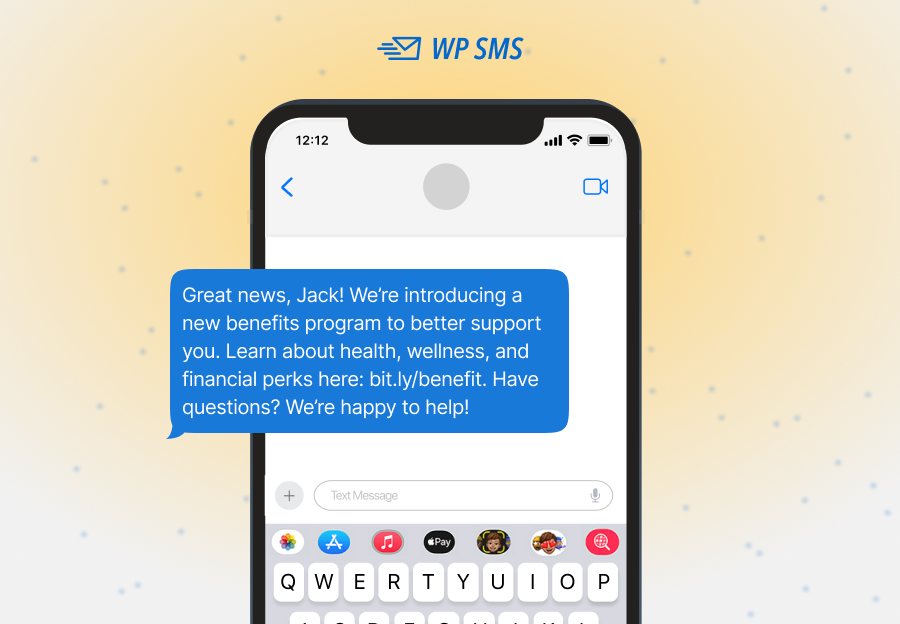
4. Payment Notifications
Payment errors and delays can lead to dissatisfaction among your employees. Your business should be ready for these situations and respond to complaints politely.
The simplest approach is to use SMS to send payment alerts and notify employees of any potential delays. It’s best to send an SMS before employees complain.
You can also remind employees of any tasks, like filling out forms or submitting timesheets, before the payroll deadline. For example, you can send a text like this:
Message
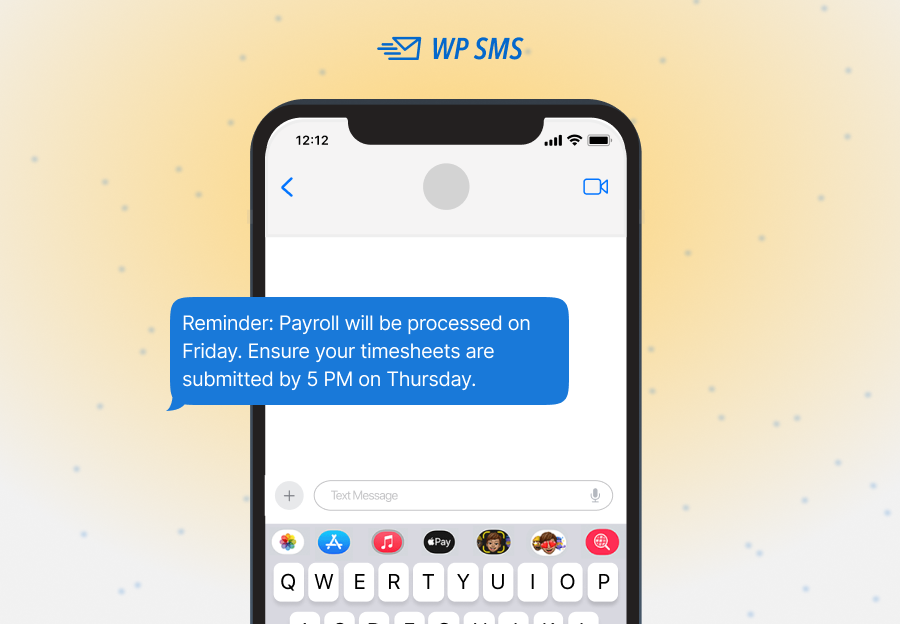
This is an interactive communication approach that helps prevent any issues regarding payments.
5. Event & Meeting Reminders
Another important use of SMS for employee communications is sending events and meeting reminders.
Employees are often busy doing multiple tasks, so they might forget about important meetings or events. SMS reminders can prevent no-shows if sent on time.
For example, if you’re hosting an all-hands meeting, you can send a text reminder:
Message
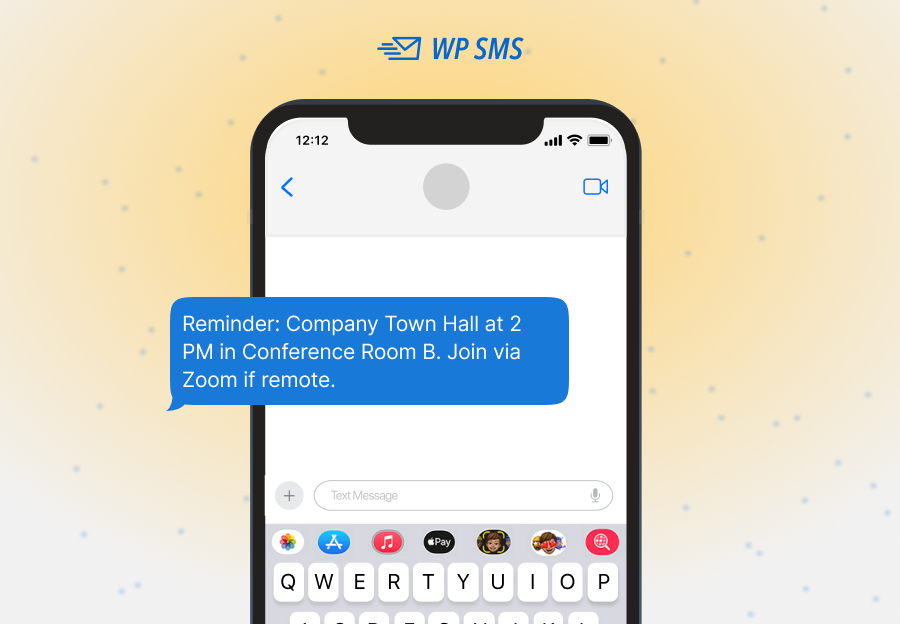
This message keeps employees informed and engaged.
6. Technical Issues
Many times, you face technical issues like website downtime or internet connection failures. In such situations, you need to inform employees of the issue to minimize disruption.
Again, SMS is the best channel to send downtime alerts to your employees. It allows IT teams to explain technical issues and also send updates on the maintenance status.
For example, imagine your email server goes down. Your IT department can send an SMS update as follows:
Message
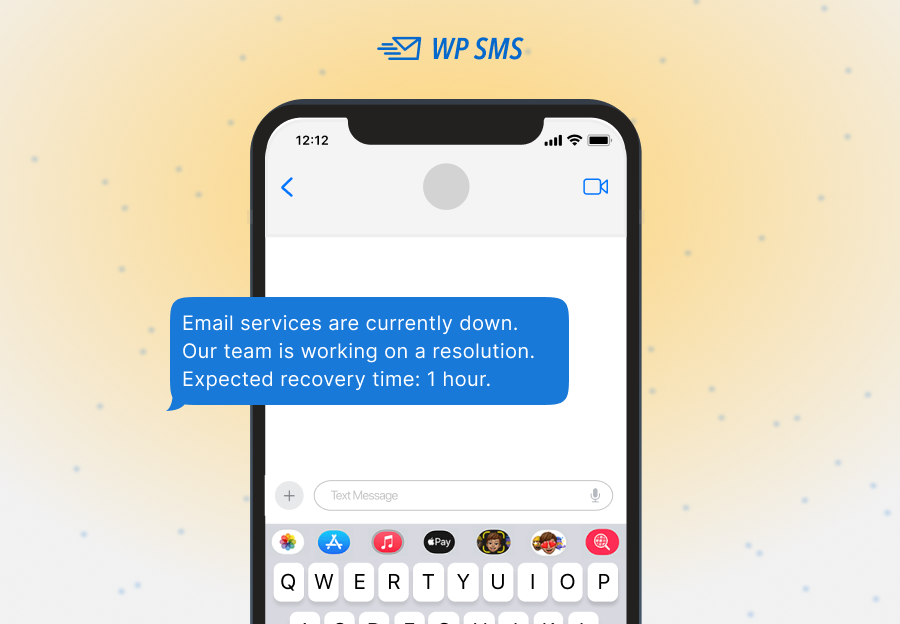
Talking to your employees about issues with this transparency helps you manage employee expectations and reduce dissatisfaction.
Best Practices for Using SMS in Employee Communications
If you want to maximize the efficiency of your internal SMS efforts, you should pay attention to the tips below.
- Keep It Short & Clear: Employees are too busy to read lengthy messages. They are more likely to read and respond to brief messages. So stick to the key points, and if more details are needed, include a link to a webpage.
- Make It Relevant: Don’t send messages to all people without considering their relevance to everyone. Try to group employees based on their roles or locations to send relevant notifications.
- Use SMS for Important Updates: If you send too many texts, your employees might start ignoring them. Keep SMS for urgent or time-sensitive information.
- Give Clear Instructions: Include a clear CTA so that your employees understand what to do. Whether you need them to confirm a meeting or pick up an extra shift, your message must be clear.
- Follow Privacy Rules: Always respect employee privacy. Make sure that their contact details are kept safe.
- Track Engagement: Try to analyze the success of your internal messaging efforts and remove your weaknesses to get better results.
Looking for a Perfect SMS Tool for Your Internal Communications?
The key to an efficient internal messaging strategy for your company is using a versatile SMS tool.
If you want to reduce manual work and automate your transactional messages, you have to go for an SMS tool with automation, scheduling, and dynamic content features.
Also, your SMS tool should integrate well with your current platforms, like your website, WooCommerce, CRM, etc.
This way, you don’t need to switch between various dashboards. Also, you can run your promotional SMS campaigns along with your internal messaging using a single tool.
WP SMS is one of the best SMS tools in this regard. It’s specifically designed for WordPress websites and supports 350+ international SMS gateways.

Take a look at its capabilities to understand why you must choose WP SMS:
- Advanced ‘Send SMS’ page to customize preferences
- Scheduled and Repeating SMS
- SMS Newsletter
- Dynamic content
- Log in and register with SMS
- Manage Subscribers
- Safe Outbox page
So don’t wait. Try the demo version of WP SMS to check out its features and then choose your pricing package right now!
Conclusion
SMS is now a handy tool for both personal and business purposes. Using SMS, team managers in companies can deliver quick alerts and updates.
SMS notifications in internal communications provide speed, reliability, and high engagement.
You can use it for emergency alerts, shift updates, company-wide announcements, or IT notifications.
Compared to emails and social chat groups, SMS is the best method to enhance efficiency and keep employees informed.
You just need to build a strong SMS strategy and use a versatile SMS platform like WP SMS to enable you to run both business-to-customer SMS campaigns and internal SMS communications.
So don’t waste your time searching for other solutions. Try the demo version of WP SMS and choose a pricing package to start your SMS communications.
FAQs
How can text messages be used to communicate with employees?
Text messages can be used for urgent alerts, shift updates, company announcements, HR notifications, and meeting reminders.
What are 5 examples of professional texts?
1. Reminder: Your shift starts at 9 AM tomorrow. Please arrive on time.
2. Urgent: Office closed due to severe weather. Work from home if possible.
3. Payment Update: Payroll has been processed. Expect direct deposits by Friday.
4. Meeting Alert: There will be a company-wide meeting at 3 PM. Join via Zoom: [link].
5. IT Alert: System maintenance from 1–3 AM. Expect temporary downtime.
What is the best SMS tool for internal communication?
It depends on your resources, requirements, and your current platforms. If you’re using a WordPress website, you’d better use an SMS plugin like WP SMS.
Can I send SMS messages from my desktop?
Yes, Google Messages is accessible using a web browser.
